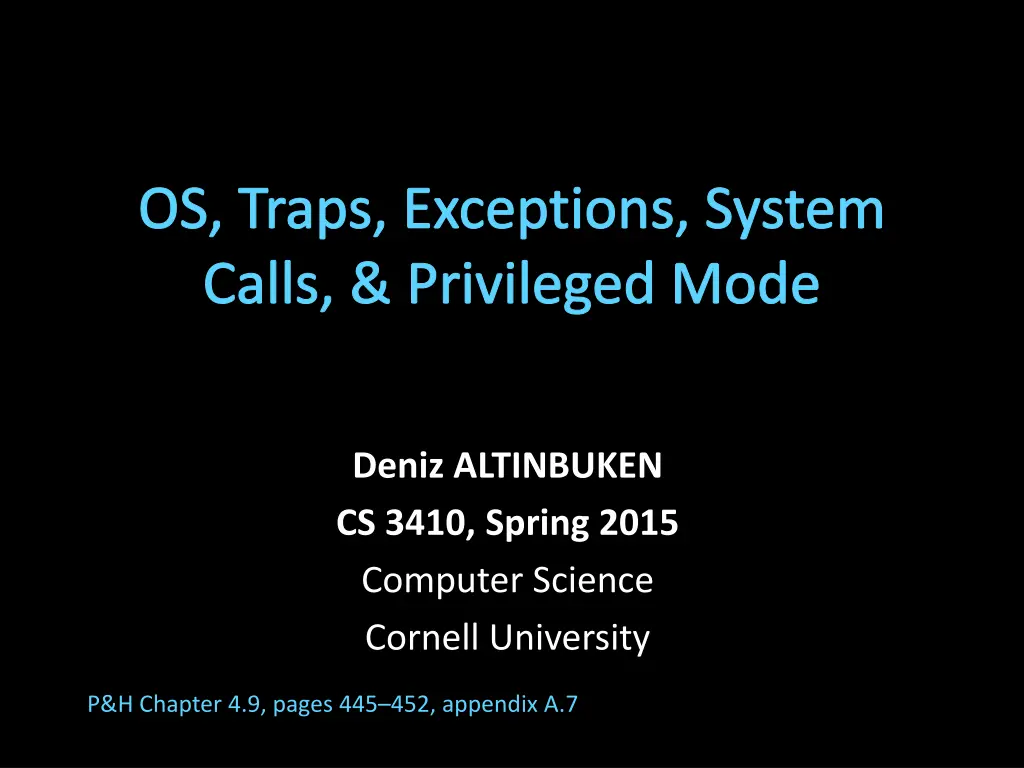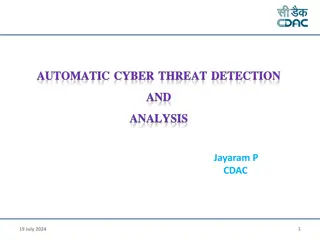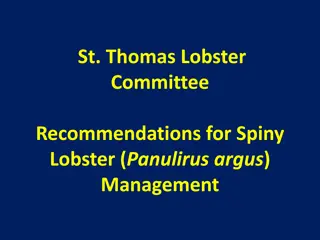
Understanding Heartbleed Security Bug and Its Implications
Explore the Heartbleed Security Bug, a critical vulnerability in OpenSSL, affecting millions of secure web servers. Learn how this bug works, its impact on Internet security, and the risks associated with it. Discover the importance of addressing vulnerabilities like Heartbleed to safeguard data and protect against potential cyber threats.
Download Presentation

Please find below an Image/Link to download the presentation.
The content on the website is provided AS IS for your information and personal use only. It may not be sold, licensed, or shared on other websites without obtaining consent from the author. If you encounter any issues during the download, it is possible that the publisher has removed the file from their server.
You are allowed to download the files provided on this website for personal or commercial use, subject to the condition that they are used lawfully. All files are the property of their respective owners.
The content on the website is provided AS IS for your information and personal use only. It may not be sold, licensed, or shared on other websites without obtaining consent from the author.
E N D
Presentation Transcript
OS, Traps, Exceptions, System Calls, & Privileged Mode Deniz ALTINBUKEN CS 3410, Spring 2015 Computer Science Cornell University P&H Chapter 4.9, pages 445 452, appendix A.7
Announcements HW2 Review Sessions! Saturday, April 18th Tuesday, April 21st Lab3 is due tomorrow! Wednesday, April 15th PA3 starts this week! The Lord of the Cache! Due Friday, April 24th
Announcements HW2-P5 (Pre-Lab4) due next week! Monday, April 20th Don t forget to submit on CMS! Designed for you to look over the code and understand virtual memory before coming to Lab 4.
Announcements Prelim 2 is on April 30th at 7 PM at Statler Hall! If you have a conflict e-mail me: deniz@cs.cornell.edu
Heartbleed Security Bug Heartbleed is a security bug disclosed in April 2014 in the open-source OpenSSL cryptography library, widely used to implement the Internet's Transport Layer Security (TLS) protocol. 17% (0.5 million) secure web servers vulnerable to bug. Netcraft Ltd.; Apr 8, 2014 Amazon, Akamai, GitHub, Wikipedia, etc. affected! worst vulnerability found since commercial traffic began to flow over the internet. Forbes; Apr 10, 2014
Heartbleed Security Bug How does it work? Keep-alive heartbeat lacked bounds checking! Buffer over-read Send me this 5 letter word if you are alive: Phone Phone Send me this 1000 letter word if you are alive: Phone Phone Alice passwd 123456 Bob passwd 654321 Server passwd
Heartbleed Security Bug Heartbeat Protocol: Client sends buffer and the length of buffer Server writes buffer in memory Returns length of characters from memory Server did not check length of buffer Malloc/Free did not clear memory Unauthenticated users can send a heartbeat Server can return sensitive information present in memory!
Takeaway Worst Internet security vulnerability found yet due systems practices 101 that we learn in CS3410, lack of bounds checking! Lab 3: Similar bug/vulnerability due to Buffer overflow Browser implementation lacks bounds checking Overwrite return address in memory using a smart input!
Outline for Today How do we protect processes from one another? Skype should not crash Chrome. How do we protect the operating system (OS) from other processes? Chrome should not crash the computer! How does the CPU and OS (software) handle exceptional conditions? Division by 0, Page Fault, Syscall, etc.
Outline for Today How do we protect processes from one another? Skype should not crash Chrome. Operating System How do we protect the operating system (OS) from other processes? Chrome should not crash the computer! Privileged Mode How does the CPU and OS (software) handle exceptional conditions? Division by 0, Page Fault, Syscall, etc. Traps, System calls, Exceptions, Interrupts
Operating System Manages all of the software and hardware on the computer. Many processes running at the same time, requiring resources CPU, Memory, Storage, etc. The Operating System multiplexes these resources amongst different processes, and isolates and protects processes from one another!
Operating System Operating System (OS) is a trusted mediator: Safe control transfer between processes Isolation (memory, registers) of processes P1 P2 P3 P4 untrusted software VM filesystem net trusted driver driver OS MMU CPU disk netw hardware card
Which statement is FALSE? A) OS is always in the Hard Disk. B) OS is always in Memory. C) All processes can access the OS code. D) OS provides a consistent API to be used by other processes. E) OS manages the CPU, Memory, Devices, and Storage.
Which statement is FALSE? A) OS is always in the Hard Disk. B) OS is always in Memory. C) All processes can access the OS code. D) OS provides a consistent API to be used by other processes. E) OS manages the CPU, Memory, Devices, and Storage. There should be a way to prevent processes from misbehaving!
Outline for Today How do we protect processes from one another? Skype should not crash Chrome. Operating System How do we protect the operating system (OS) from other processes? Chrome should not crash the computer! Privileged Mode How does the CPU and OS (software) handle exceptional conditions? Division by 0, Page Fault, Syscall, etc. Traps, System calls, Exceptions, Interrupts
Privileged Mode Only privileged (and trusted!) processes can access & change important things. Editing TLB, Page Tables, OS code, $sp, $fp If an untrusted process could change $sp, $fp, and $gp, OS would crash!
Privileged Mode How can we get the privileged mode to work? Attempt #1: Make privileged instructions and registers available only to OS Code ! OS Code resides in memory at preset virtual address
Privileged Mode Would making privileged instructions and registers available only to OS Code work? A) Will work great! B) Will work, but performance will be slow! C) Will not work because any process can jump into OS code D) Will not work because process can access all registers E) Whatever, I am bored!
Privileged Mode Would making privileged instructions and registers available only to OS Code work? A) Will work great! B) Will work, but performance will be slow! C) Will not work because any process can jump into OS code D) Will not work because process can access all registers E) Whatever, I am bored!
Privileged Mode How can we get the privileged mode to work? Attempt #1: Make privileged instructions and registers available only to OS Code OS Code resides in memory at preset virtual address Does not work: Process can still JAL into middle of OS functions Process can still access and change memory, page tables,
Privileged Mode How can we get the privileged mode to work? Attempt #2: CPU Mode Bit in Privilege Level Status Register Mode 0 = untrusted = user mode Privileged instructions and registers are disabled by CPU Mode 1 = trusted = kernel mode All instructions and registers are enabled
Privileged Mode How can we get the privileged mode to work? Boot sequence: load first sector of disk (containing OS code) to predetermined address in memory Mode 1; PC predetermined address OS takes over initializes devices, MMU, timers, etc. loads programs from disk, sets up page tables, etc. Mode 0; PC program entry point
Privileged Mode If an untrusted process does not have privileges to use system resources, how can it Use the screen to print? Send message on the network? Allocate pages? Schedule processes? System Calls
System Calls System call: Not just a function call Don t let process ram jump just anywhere in OS code OS can t trust process registers (sp, fp, gp, etc.) SYSCALL instruction: safe transfer of control to OS Mode 0; Cause syscall; PC exception vector MIPS system call convention: Exception handler saves temp regs, saves ra, but: $v0 = system call number, which specifies the operation the application is requesting
User Application printf() User Mode System Call Interface Privileged (Kernel) Mode SYSCALL! 0xfffffffc top printf.c Implementation of printf() syscall! system reserved 0x80000000 0x7ffffffc stack dynamic data (heap) static data 0x10000000 .data code (text) .text 0x00400000 0x00000000 bottom system reserved
System Calls System call examples: putc(): Print character to screen Need to multiplex screen between competing processes send(): Send a packet on the network Need to manipulate the internals of a device sbrk(): Allocate a page Needs to update page tables & MMU sleep(): put current prog to sleep, wake other Need to update page table base register
Invoking System Calls int getc() { asm("addiu $v0, $0, 4"); asm("syscall"); } char *gets(char *buf) { while (...) { buf[i] = getc(); } }
Libraries and Wrappers Compilers do not emit SYSCALL instructions Compiler doesn t know OS interface Libraries implement standard API from system API libc (standard C library): getc() syscall sbrk() syscall write() syscall gets() getc() printf() write() malloc() sbrk()
Where does the OS live? In its own address space? But then syscall would have to switch to a different address space Also harder to deal with syscall arguments passed as pointers So in the same address space as process Use protection bits to prevent user code from writing kernel Higher part of virtual memory, lower part of physical memory
Anatomy of a Process 0xfffffffc top system reserved 0x80000000 0x7ffffffc stack dynamic data (heap) 0x10000000 static data .data code (text) .text 0x00400000 0x00000000 bottom system reserved
Full System Layout Typically all kernel text, most data At same virtual address in every address space Map kernel in contiguous physical memory when boot loader puts kernel into physical memory OS Stack 0xfffffffc OS Heap OS Data OS Text 0x80000000 0x7ffffffc stack The OS is omnipresent and steps in where necessary to aid application execution Typically resides in high memory dynamic data (heap) 0x10000000 static data code (text) 0x00400000 When an application needs to perform a privileged operation, it needs to invoke the OS system reserved 0x00000000 Virtual Memory
Full System Layout OS Stack 0xfffffffc OS Heap OS Data OS Text 0x80000000 0x7ffffffc stack dynamic data (heap) OS Stack 0x10000000 static data OS Heap code (text) OS Data 0x00400000 OS Text system reserved 0x00000000 0x00...00 Virtual Memory Physical Memory
SYSCALL instruction SYSCALL instruction does an atomic jump to a controlled location (i.e. MIPS 0x8000 0180) Switches the sp to the kernel stack Saves the old (user) SP value Saves the old (user) PC value (= return address) Saves the old privilege mode Sets the new privilege mode to 1 Sets the new PC to the kernel syscall handler
SYSCALL instruction Kernel system call handler carries out the desired system call Saves callee-save registers Examines the syscall number Checks arguments for sanity Performs operation Stores result in v0 Restores callee-save registers Performs a return from syscall (ERET) instruction, which restores the privilege mode, SP and PC
Takeaway It is necessary to have a privileged (kernel) mode to enable the Operating System (OS): provides isolation between processes protects shared resources provides safe control transfer
Outline for Today How do we protect processes from one another? Skype should not crash Chrome. Operating System How do we protect the operating system (OS) from other processes? Chrome should not crash the computer! Privileged Mode How does the CPU and OS (software) handle exceptional conditions? Division by 0, Page Fault, Syscall, etc. Traps, System calls, Exceptions, Interrupts
Terminology Trap: Any kind of a control transfer to the OS Syscall: Synchronous and planned, process-to- kernel transfer SYSCALL instruction in MIPS (various on x86) Exception: Synchronous but unplanned, process-to- kernel transfer exceptional events: div by zero, page fault, page protection err, Interrupt: Asynchronous, device-initiated transfer e.g. Network packet arrived, keyboard event, timer ticks
Exceptions Exceptionsare any unexpected change in control flow. Interrupt -> cause of control flow change external Exception -> cause of control flow change internal Exception: Divide by 0, overflow Exception: Bad memory address Exception: Page fault Interrupt: I/O interrupt (e.g. keyboard stroke) We need both HW and SW to help resolve exceptions Exceptions are at the hardware/software boundary
Hardware/Software Boundary Hardware support for exceptions Exception program counter (EPC) A 32-bit register to hold the addr of the affected instruction. Syscall case: Address of SYSCALL Cause register A register to hold the cause of the exception. Syscall case: 8, Sys Special instructions to load TLB Only do-able by kernel Precise and imprecise exceptions In pipelined architecture Have to correctly identify PC of exception MIPS and modern processors support this
Exceptions EPC Code Stored in Memory (also, data and stack) Cause compute jump/branch targets $0 (zero) $1 ($at) A memory register file $29 ($sp) $31 ($ra) D D alu B +4 addr inst PC din dout M control B memory imm extend new pc forward unit detect hazard Stack, Data, Code Stored in Memory Instruction Decode Write- Back Instruction Fetch ctrl ctrl ctrl Memory Execute IF/ID ID/EX EX/MEM MEM/WB
Hardware/Software Boundary Precise exceptions: Hardware guarantees (similar to a branch) Previous instructions complete Later instructions are flushed EPC and cause register are set Jump to prearranged address in OS When you come back, restart instruction Disable exceptions while responding to one Otherwise can overwrite EPC and cause
Hardware/Software Boundary What else requires both Hardware and Software? A) Virtual to Physical Address Translation B) Branching and Jumping C) Clearing the contents of a register D) Pipelining instructions in the CPU E) What are we even talking about?
Hardware/Software Boundary What else requires both Hardware and Software? A) Virtual to Physical Address Translation B) Branching and Jumping C) Clearing the contents of a register D) Pipelining instructions in the CPU E) What are we even talking about?
Hardware/Software Boundary Virtual to physical address translation! Hardware CPU has a concept of operating in physical or virtual mode. CPU helps manage the TLB. CPU raises page faults. CPU keeps Page Table Base Register (PTBR) and ProcessID Software OS manages Page Table storage OS handles Page Faults OS updates Dirty and Reference bits in the Page Tables OS keeps TLB valid on context switch: Flush TLB when new process runs (x86) Store process id (MIPS)
Summary Trap Any kind of a control transfer to the OS Syscall Synchronous, process-initiated control transfer from user to the OS to obtain service from the OS e.g. SYSCALL Exception Synchronous, process-initiated control transfer from user to the OS in response to an exceptional event e.g. Divide by zero, TLB miss, Page fault Interrupt Asynchronous, device-initiated control transfer from user to the OS e.g. Network packet, I/O complete
What is the difference between traps, exceptions, interrupts, and system calls?
Interrupts & Exceptions Hardware CPU saves PC of exception instruction (EPC) CPU Saves cause of the interrupt/privilege (Cause register) Switches the sp to the kernel stack Saves the old (user) SP value Saves the old (user) PC value Saves the old privilege mode Sets the new privilege mode to 1 Sets the new PC to the kernel interrupt/exception handler






















